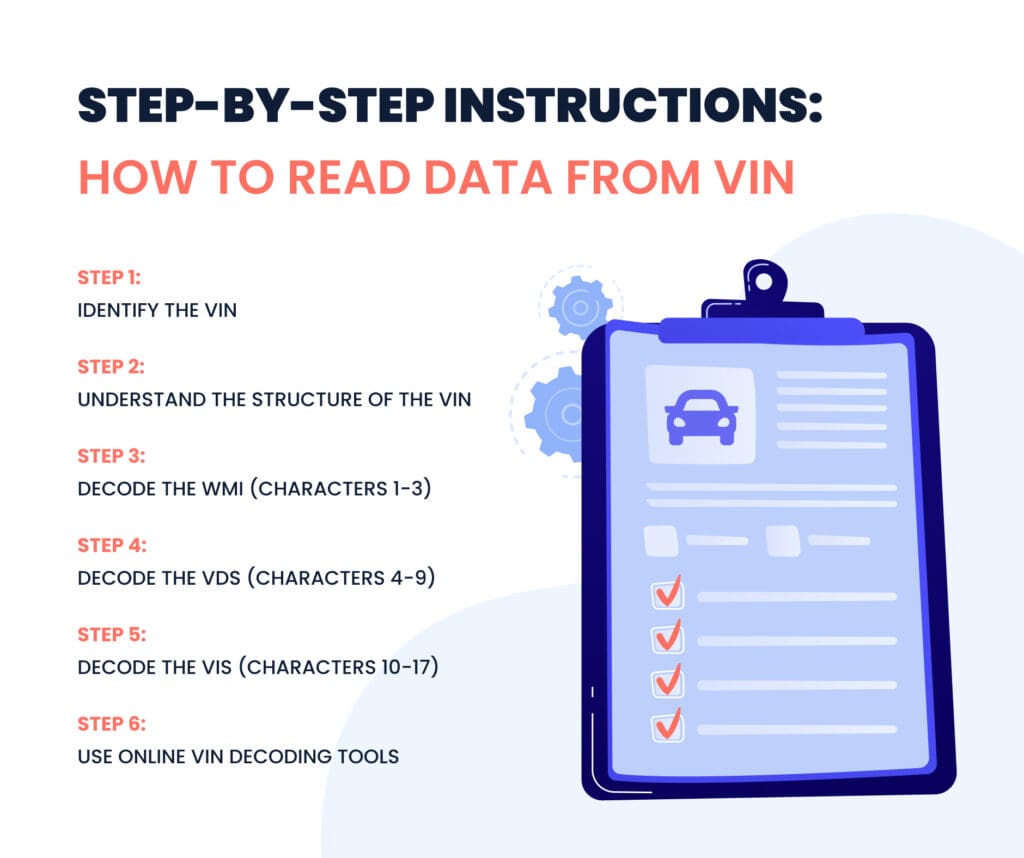Every automobile has a number called a vehicle identification code. For every automobile, it functions as their phone number. Understanding the VIN of a vehicle will expose a lot about its manufacturer, type, year of production, and country of manufacture. Though this data might be helpful, when sharing or decoding your VIN you must protect your privacy. This post will go over how to decipher a VIN history and provide ideas on personal information protection.
What is VIN and why do we need to decode it?
A 17-character string called a vehicle identification number (VIN) allows one to uniquely identify a car. It seems like the fingerprint of the automobile Statvin. It tells you important details such as its make, model, engine type, year of production, manufacturing site, and even safety features.
Knowing how to read a vehicle’s VIN enables technicians, buyers, and owners to confirm important information about the background and traits of a car. Using a VIN, find if the car has been stolen or tampered with, find when it was built, and find whether it has been in any accidents. One now needs deleting VIN history to guarantee it is legal and safe before buying or fixing a car. For individuals worried about prior car problems or privacy, deleting VIN information might also be a choice. Guaranteeing the automobile is legal and safe before purchasing or repairing it depends on an awareness of the VIN, thereby guaranteeing openness and peace of mind.
Structure and components of the VIN number
A VIN number consists of three main components: the WMI, the VDS, and the VIS. There is specific information about the car in each area.
WMI (World Manufacturer Identifier): the manufacturer’s code
The WMI, which distinguishes the manufacturer of the car and its country of origin, consists of the first three VIN characters. Given that it indicates the nation or location where the car was manufactured, the first character in this part is very significant. A “1” denotes a car produced in the United States, for example; “J” denotes Japan; “S” stands for the United Kingdom. The second and third letters zero in on the particular manufacturer or brand. For Honda automobiles manufactured in the USA, “1HG” is the WMI used, for instance. This section of the VIN facilitates fast identification of the geographical origins of the automobile and the manufacturing business in charge.

VDS (Vehicle Descriptor Section): technical characteristics of the car
Comprising characters 4 to 9, the VDS details the technical characteristics of the vehicle including its model, body style, engine type, and gearbox. Information particular to the design of the vehicle is encoded here. While the VDS includes the details of the car’s construction and characteristics, the WMI provides broad manufacturer and geographical data. It could show, for example, whether the automobile is a sedan or SUV, whether it has a manual or automatic gearbox or the kind of engine it runs on. Unlike the WMI, which is standardized, the VDS portion is particular to every manufacturer and could vary in format from one brand to another.
VIS (Vehicle Identifier Section): unique vehicle identifier
The last eight letters of the VIN comprise the VIS, which distinguishes every car built. Important information like the manufacture year of the vehicle, the factory code, which indicates where the automobile was built, and the special serial number issued to that particular car is included in this part. Though they are of the same make and model, the VIS guarantees that no two cars have the same identity. For instance, this section of the VIN lets one find the precise manufacturer vehicle’s history and trace if a vehicle belonged to a certain production batch. Vehicle registration, ownership monitoring, and situations where a car’s history must be confirmed, such as when purchasing or selling a secondhand car, all depend on this element.
Step-by-step instructions: how to read data from VIN
Reading data from a VIN means dissecting the 17-character code into three primary sections: WMI, VDS, and VIS. This detailed instruction will enable you to decipher a VIN step by step:
Step 1: Identify the VIN
In the car, find the VIN. Usually placed near the door latch on the driver’s side door frame or the dashboard next to the windscreen, the registration records of the car can potentially reveal it.
Step 2: Understand the Structure of the VIN
There are seventeen characters in a VIN, numbers, and letters among other things. The characters are divided into three sections:
- WMI (World Manufacturer Identifier): Characters 1 to 3.
- VDS (Vehicle Descriptor Section): Characters 4 to 9.
- VIS (Vehicle Identifier Section): Characters 10 to 17.
Step 3: Decode the WMI (Characters 1-3)
The first three numbers of the VIN called the World Manufacturer Identifier (WMI), tell you who made the car and where it was made.
- Character 1. Shows the area or nation of the manufacturing location. For example:
- “1” or “4” indicates the United States.
- “J” indicates Japan.
- “S” indicates the United Kingdom.
- Characters 2 and 3. These pinpoint the brand or maker. For example:
- “1HG” stands for Honda vehicles made in the USA.
- “WA1” stands for Audi vehicles made in Germany.
Step 4: Decode the VDS (Characters 4-9)
The Vehicle Descriptor Section (VDS), which offers particular information on the model, body style, engine, and other attributes of the vehicle, consists of the following six characters, positions 4 through 9. Usually exclusive to manufacturers, this part differs across vehicle brands.
- For example:
- The model could be identified as a sedan, hatchback, or SUV;
- The engine type could be listed as a V6, V8, or electric;
- The transmission type could indicate whether it’s automatic or manual.
Step 5: Decode the VIS (Characters 10-17)
Uniquely identifying the vehicle, the following eight characters, positions 10 through 17, form the Vehicle Identifier Section (VIS). You should search for:
- Character 10. Shows the model year of the car. For 1980, “A,” for 1981, “B,” for 2001, “1,” for 2009, “9.”
- Character 11. Identifies the assembly plant where the vehicle was produced. For example:
- “N” might indicate a factory in Michigan, USA.
- Characters 12-17. These are the unique serial numbers of the vehicle. These last digits are used to distinguish your vehicle from all others.
Step 6: Use Online VIN Decoding Tools
Online VIN decoding tools can help you to confirm the data even further. To get thorough knowledge about the manufacturer, model, features, and more of the automobile, enter the VIN in a VIN decoder.
Suppose the VIN is 1HGCM82633A123456, for instance.
- WMI
- “1HG” = Honda, made in the USA.
- VDS
- “CM8263” = This might point to a particular model, body design, engine type (4-cylinder engine), and automatic gearbox Honda Accord sedan, uses.
- VIS
- “3A123456” = “3” represents the model year (2003), “A” represents the assembly plant, and “123456” is the vehicle’s unique serial number.
Threats to car owner’s privacy
Particularly as cars become increasingly linked and equipped with cutting-edge technologies, car owners run different risks to their privacy. These are some major hazards:
- Tracking and Location Monitoring
- Many contemporary vehicles use GPS systems designed to track position. If these technologies are compromised or abused, automobile owners’ movements might be watched without their permission.
- Particularly with insurance companies or manufacturers, telematics systems, which track driving patterns and vehicle performance, may be sent to other parties without the owner’s knowledge.
- Sometimes owners of cars search for ways to minimize monitoring, such as delete car history.
- Data Breaches and Cyber Attacks
- Cars with Bluetooth, Wi-Fi, and infotainment systems may be hacked easily. Cybercriminals may access sensitive information including contacts, messages, and even personal preferences should the system be improperly protected.
- Car manufacturers could also gather data on vehicle use. If the database is hacked, personal information might be revealed.
- In-Vehicle Surveillance
- For convenience and safety, several cars have inside cameras or microphones to track drivers and passengers. One may hack or use these characteristics for monitoring needs.
- Some linked automobiles log conversations or activity within the vehicle, which might be utilized without permission for advertising or profiling needs.
- Third-Party Access
- Sometimes dealerships and automobile renting companies have access to a car’s data. Inappropriate security practices might let unauthorized people access confidential data kept in the car.
- Smartphone applications connected to the automobile, such as remote start or remote unlocking apps, might reveal personal information should their security be hacked.
- Car Key Hacking
- Though handy, modern keyless entry systems can easily be hacked. By intercepting signals from the car’s key fob, attackers may unlock and run the vehicle without authorization from the owner.
- Key fobs’ signal range may be extended via relay assaults, which lets criminals access the automobile while the owner is not aware.
- Third-Party App Privacy
- Many current cars let owners link their cell phones to the system via outside applications. These programs could access personal information, driving habits, and location history of an automobile, therefore exposing it to unapproved users.
- Vehicle-to-Vehicle Communication
- Although their major objective is to make automobiles safer and enable better working together, new vehicle-to-vehicle (V2V) transmission technologies might create hazards. If improperly secured, these technologies might be used to monitor vehicle movements or interfere with vehicle operations.
To lessen these risks, vehicle owners need to:
- Frequent updates of their car’s software and applications help to guarantee vulnerabilities are fixed;
- On linked devices and systems, turn on encryption and use strong passwords;
- Share data carefully. Only allow access for required capabilities;
- Review and delete VIN history often to guard against long-term monitoring or illegal access.
Personal data protection: what to do with VIN?
Safeguarding your privacy depends on you safeguarding your VIN. These are key actions to maintain your VIN safe:
- Limit disclosure. Share your VIN only as needed, for registration or official transactions. Steer clear of distributing it to untested purchasers or publishing.
- Verify requests. Make sure your VIN requests originate from reliable sources, such as government agencies or insurance companies. One should be wary of phishing schemes.
- Use secure VIN decoders. To safeguard your personal information, choose reliable and safe providers for VIN decoding.
- Protect from theft. Keep records with your VIN safely and think about anti-theft devices based on VIN-based tracking systems.
- Monitor history. Using a reliable car’s history, routinely search for VIN cloning or abuse.
- Shred documents. Get any records with your VIN properly disposed of to stop illegal access.
- Encrypt vehicle data. Make sure the telematics and linked systems in your car are safe using privacy settings and passwords.
- Update security. Update the software in your car often and activate privacy settings to guard private information.
- Secure parking. Park your vehicle in safe places and give thought to utilizing security systems to stop unwanted entry.
Conclusion: combining transparency and security
Managing your VIN requires careful balancing of openness with security. Although the VIN offers insightful information about the car history and specs, you should guard this information from any hazards and abuse. If you like to remove car history, you must be additionally careful to safeguard your personal information. You may protect your data and yet gain from the VIN’s openness by restricting exposure, authenticating requests, utilizing safe technologies, and putting strong privacy policies into place. Giving security and openness a priority guarantees that the identity of your car stays under protection, therefore preventing privacy violations, fraud, and theft.
The New Jersey Digest is a new jersey magazine that has chronicled daily life in the Garden State for over 10 years.
- Staffhttps://thedigestonline.com/author/thedigeststaff/
- Staffhttps://thedigestonline.com/author/thedigeststaff/
- Staffhttps://thedigestonline.com/author/thedigeststaff/
- Staffhttps://thedigestonline.com/author/thedigeststaff/


